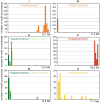Identification of chromosome sequence motifs that mediate meiotic pairing and synapsis in C. elegans
- PMID: 19620970
- PMCID: PMC4001799
- DOI: 10.1038/ncb1904
Identification of chromosome sequence motifs that mediate meiotic pairing and synapsis in C. elegans
Erratum in
- Nat Cell Biol. 2009 Sep;11(9):1163
Abstract
Caenorhabditis elegans chromosomes contain specialized regions called pairing centres, which mediate homologous pairing and synapsis during meiosis. Four related proteins, ZIM-1, 2, 3 and HIM-8, associate with these sites and are required for their essential functions. Here we show that short sequence elements enriched in the corresponding chromosome regions selectively recruit these proteins in vivo. In vitro analysis using SELEX indicates that the binding specificity of each protein arises from a combination of two zinc fingers and an adjacent domain. Insertion of a cluster of recruiting motifs into a chromosome lacking its endogenous pairing centre is sufficient to restore homologous pairing, synapsis, crossover recombination and segregation. These findings help to illuminate how chromosome sites mediate essential aspects of meiotic chromosome dynamics.
Figures






Comment in
-
Homologue pairing: getting it right.Nat Cell Biol. 2009 Aug;11(8):917-8. doi: 10.1038/ncb0809-917. Nat Cell Biol. 2009. PMID: 19648975
Similar articles
-
Homologue pairing: getting it right.Nat Cell Biol. 2009 Aug;11(8):917-8. doi: 10.1038/ncb0809-917. Nat Cell Biol. 2009. PMID: 19648975
-
HIM-8 binds to the X chromosome pairing center and mediates chromosome-specific meiotic synapsis.Cell. 2005 Dec 16;123(6):1051-63. doi: 10.1016/j.cell.2005.09.035. Cell. 2005. PMID: 16360035 Free PMC article.
-
Synaptonemal Complex Components Are Required for Meiotic Checkpoint Function in Caenorhabditis elegans.Genetics. 2016 Nov;204(3):987-997. doi: 10.1534/genetics.116.191494. Epub 2016 Sep 7. Genetics. 2016. PMID: 27605049 Free PMC article.
-
Homologue pairing, recombination and segregation in Caenorhabditis elegans.Genome Dyn. 2009;5:43-55. doi: 10.1159/000166618. Genome Dyn. 2009. PMID: 18948706 Review.
-
Chromosome pairing and synapsis during Caenorhabditis elegans meiosis.Curr Opin Cell Biol. 2013 Jun;25(3):349-56. doi: 10.1016/j.ceb.2013.03.003. Epub 2013 Apr 8. Curr Opin Cell Biol. 2013. PMID: 23578368 Free PMC article. Review.
Cited by
-
Control of Meiotic Crossovers: From Double-Strand Break Formation to Designation.Annu Rev Genet. 2016 Nov 23;50:175-210. doi: 10.1146/annurev-genet-120215-035111. Epub 2016 Sep 14. Annu Rev Genet. 2016. PMID: 27648641 Free PMC article. Review.
-
Enrichment of H3K9me2 on Unsynapsed Chromatin in Caenorhabditis elegans Does Not Target de Novo Sites.G3 (Bethesda). 2015 Jul 8;5(9):1865-78. doi: 10.1534/g3.115.019828. G3 (Bethesda). 2015. PMID: 26156747 Free PMC article.
-
Direct recognition of homology between double helices of DNA in Neurospora crassa.Nat Commun. 2014 Apr 3;5:3509. doi: 10.1038/ncomms4509. Nat Commun. 2014. PMID: 24699390 Free PMC article.
-
Transcription-independent TFIIIC-bound sites cluster near heterochromatin boundaries within lamina-associated domains in C. elegans.Epigenetics Chromatin. 2020 Jan 9;13(1):1. doi: 10.1186/s13072-019-0325-2. Epigenetics Chromatin. 2020. PMID: 31918747 Free PMC article.
-
GRAS-1 is a novel regulator of early meiotic chromosome dynamics in C. elegans.PLoS Genet. 2023 Feb 21;19(2):e1010666. doi: 10.1371/journal.pgen.1010666. eCollection 2023 Feb. PLoS Genet. 2023. PMID: 36809245 Free PMC article.
References
-
- Zetka M, Rose A. The genetics of meiosis in Caenorhabditis elegans. Trends Genet. 1995;11:27–31. - PubMed
Publication types
MeSH terms
Substances
Grants and funding
LinkOut - more resources
Full Text Sources
Other Literature Sources
Research Materials

